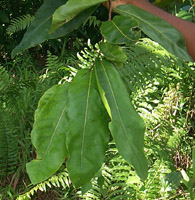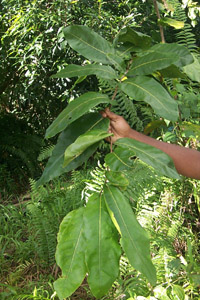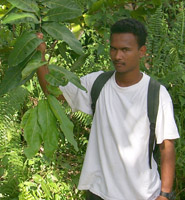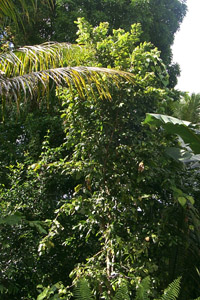







Identification based on:
http://www.ars-grin.gov/cgi-bin/npgs/html/splist.pl?6046
http://pppis.fao.org/GPPIS.exe$ShowHost?Host=1261
Inocarpus fagifer
Authority: (Parkinson)Fosberg
Family:Leguminosae:Papilionoideae:Fabaceae
Synonyms: Inocarpus edulis J R & G Forster, Inocarpus fagiferus and Bocca edulis
Common names: Tahitian chestnut, Polynesian chestnut, namambe, nemap, noumap, taha, ivi,
ifi, Polynesian or, Aila
From oral report: Put dead leaves that have fallen from the tree on the fire. Put the legs of a two to three month old baby in the smoke that comes up until the leaves are ashes. The baby will walk by the seventh month.
From written report:
September 24, 2002
Chuukese Name: Kurek
Collector:Lisa Santer
Local use:It helps the babies to walk early in their monthly old.
How to prepare it:
We take the leaves of this plant.we only take the death onces,the one that are already on the ground. We can take as many as we want ,but all the leaves will be all even, we can not take three,five and so on because that not how we applied and it won't work.As i said the leaves will be all even. Then we take the leaves put it on the fire and when the smoke comes up, we pick up the baby put her or him into the smoke and then you hold until the leaves becomes ashes.This local medicine will work if we apply it everyday,because as a result your baby can stand on their feet and walk in their 6 or 7 months. - Lisa Santer, Chuuk state, living on Pohnpei
Cultural usage(if any?): The seed is used for consuming. when the seeds are mature the local people take them and boil. until it is cooked, the seeds itself tend to open. the knife is used to split the coating of the seed and take out the seed from the inside. the seed is what the local people consumed and in many different ways. it can be grinded and mixed with sugars and grinded copra, it can be grinded and mixed with grinded copra then boil it again.Or it can be consumed right after boiling and the spliting of the nut.The wood itself is used for firewood esp. when the wood is dead. Some people might have some parts of it used for their family secrets medicine. - John Gelag
Contact information for John Gelag, Yapese contributor: johngelag2@yahoo.com, johngelag2@hotmail.com. John Gelag's Web Page